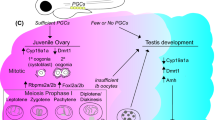Abstract.
Triturus cristatus carnifex provides a particularly clear example of sexual dimorphism for chiasma frequency and localisation. Oocytes from normal XX females routinely carry one proximal chiasma on each arm of their lampbrush bivalents. Spermatocytes from normal XY males have more numerous and relatively distal chiasmata. Lampbrush chromosomes from the oocytes of sex-reversed XY neofemales are found to resemble those from normal oocytes in having one proximal chiasma on each bivalent arm. A comparison of particular markers on the heteromorphic long arm of chromosome 1 provides evidence to equate the lampbrush 1A to somatic 1A, and confirms previous reports that lampbrush chromosome 1A is slightly longer than 1B. The XY sex bivalent of neofemales does not show any obvious heteromorphy of recognised marker loops.
Similar content being viewed by others
Author information
Authors and Affiliations
Additional information
Received: 9 September 1997 / Accepted: 16 October 1997
Rights and permissions
About this article
Cite this article
Wallace, H., Wallace, B. & Badawy, G. Lampbrush chromosomes and chiasmata of sex-reversed crested newts. Chromosoma 106, 526–533 (1997). https://doi.org/10.1007/s004120050275
Issue Date:
DOI: https://doi.org/10.1007/s004120050275




